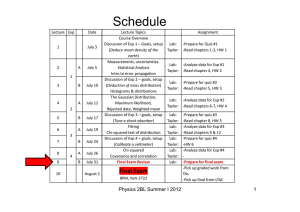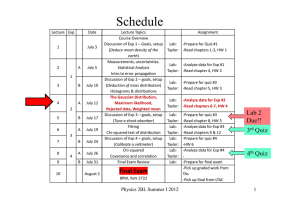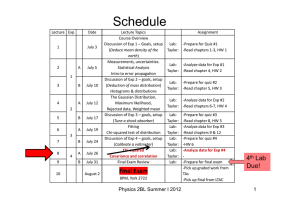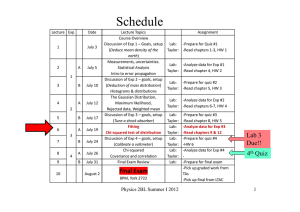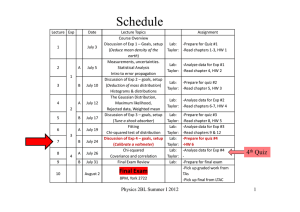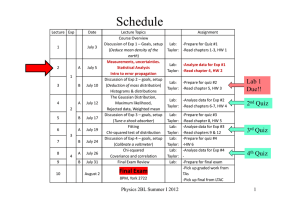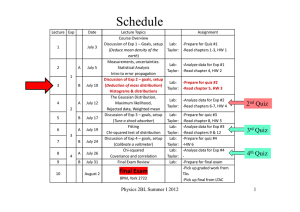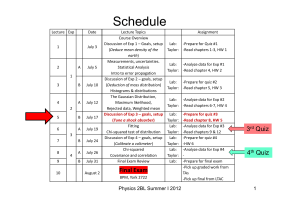Physics 2BL: Experiments in Mechanics and Electricity Summer Session I, 2012
advertisement
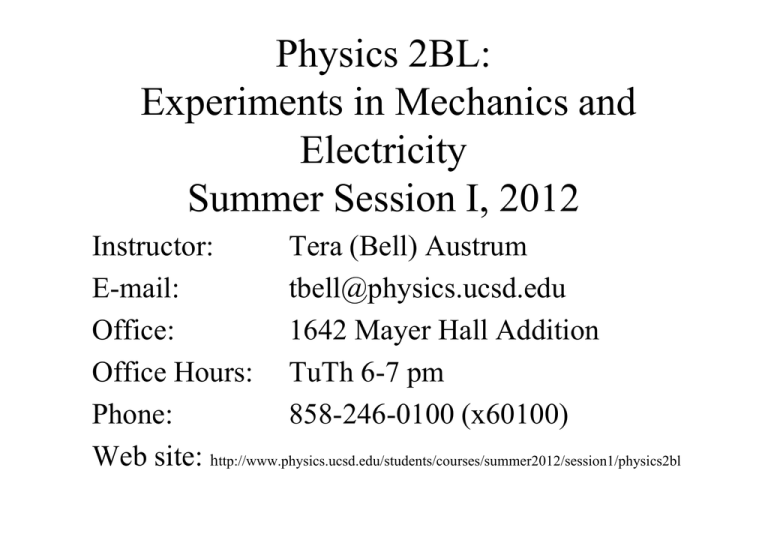
Physics 2BL: Experiments in Mechanics and Electricity Summer Session I, 2012 Instructor: Tera (Bell) Austrum E-mail: tbell@physics.ucsd.edu Office: 1642 Mayer Hall Addition Office Hours: TuTh 6-7 pm Phone: 858-246-0100 (x60100) Web site: http://www.physics.ucsd.edu/students/courses/summer2012/session1/physics2bl Physics 2BL: Experiments in Mechanics and Electricity TA Coordinator: Chris Murphy cwmurphy@ucsd.edu Office Hours: Mondays 10am-12pm MHA 2722 (Lab room) First Name His-Ming Forrest Daniel Last Name Chang Sheldon Walsh e-mail h2chang@ucsd.edu fsheldon@ucsd.edu dkwalsh@ucsd.edu TAs 9-11:50 am 12-2:50 pm 3-5:50 pm Lectures: TuTh 8-8:50pm Physics 2BL Summer I 2012 Tuesday/Thursday Section: 747203 Chang Walsh A50 Section: 747204 Chang Sheldon A51 Section: 747205 Walsh Sheldon A52 2 Today’s Lecture: • Logistics – – – – Schedule Text book Grading Lab reports, HW… • Course general introduction, overview • Introduction to Experiment #1 – Error and uncertainties – How to report results – significant figures Physics 2BL Summer I 2012 3 Course Logistics • Please refer to course web site • All announcements will be made there – All course materials posted there: • • • • Lecture notes Experimental Guidelines Grading rubrics HW assignments and Solutions • Next slides contain details about: – – – – – NOTE schedule! (do not miss the final exam – NO excuses) Text book Grading policy Lab reports and notebooks Importance of homework exercises => If you have any special needs/issues, please come see me!!!! Physics 2BL Summer I 2012 4 Schedule Lecture Exp Date A July 5 3 B July 10 4 A July 12 5 B July 17 6 A July 19 B July 24 A July 26 B July 31 Lecture Topics Course Overview Discussion of Exp 1 – Goals, setup (Deduce mean density of the earth) Measurements, uncertainties. Statistical Analysis Intro to error propagation Discussion of Exp 2 – goals, setup (Deduction of mass distribution) Histograms & distributions The Gaussian Distribution, Maximum likelihood, Rejected data, Weighted mean Discussion of Exp 3 – goals, setup (Tune a shock absorber) Fitting Chi-squared test of distribution Discussion of Exp 4 – goals, setup (Calibrate a voltmeter) Chi-squared Covariance and correlation Final Exam Review August 2 Final Exam 1 July 3 2 1 2 3 7 8 9 10 4 Assignment Lab: -Prepare for Quiz #1 Taylor: -Read chapters 1-3, HW 1 Lab: -Analyze data for Exp #1 Taylor: -Read chapter 4, HW 2 1st Quiz Lab: -Prepare for quiz #2 Taylor: -Read chapter 5, HW 3 Lab: -Analyze data for Exp #2 Taylor: -Read chapters 6-7, HW 4 Lab: Taylor: Lab: Taylor: Lab: Taylor: Lab: Taylor: Lab: 8PM, York 2722 Physics 2BL Summer I 2012 -Prepare for quiz #3 -Read chapter 8, HW 5 -Analyze data for Exp #3 -Read chapters 9 & 12 -Prepare for quiz #4 -HW 6 -Analyze data for Exp #4 -Prepare for final exam -Pick up graded work from TAs -Pick up final from LTAC 2nd Quiz 3rd Quiz 4th Quiz 5 Readings - Text - Homework Introduction to Error Analysis, by Taylor No experimental information, but easy to read and contains very good info on how to handle data. Helpful with error analysis, conclusion writing… Source of HW problems (very similar to final) Many helpful examples! Important physics background: Fundamentals of Physics, Halliday, Resnick & Walker 7th Ed. Physics 2BL Summer I 2012 6 Grading • Quizzes 20% • Lab Reports 40% • Final Exam 40% • (Extra credit) ≤5% ___________________________ 100% • Preparation is key for labs! • Time is limited, so be prepared to perform the experiment • If you run out of time, plan to attend LTAC office hours • Mondays 10am-12pm Details: Quizzes (4) 5% each (graded out of 10 points) Quiz questions come directly from pre-lab & homework questions (perhaps with some numbers changed Lab Reports (4) 10% each Description of the experiment, diagram of apparatus, presentation of the data, error analysis, calculations, discussion and conclusions Final Exam (1) 40% Final will ask questions about the labs and similar to homework Extra Credit ≤5% Buy & register a clicker, participate Physics 2BL Summer I 2012 7 Grading Policy • ABSOLUTE grading scale ≥95% ≥90% & <95% ≥85% & <90% A+ A A- ≥80% & <85% ≥75% & <80% ≥65% & <75% B+ B B- ≥60% & <65% ≥55% & <60% ≥50% & <55% C+ C C- ≥40% & <50% D <40% F Grade scale may be adjusted, but only in a way that benefits you (If everyone gets above 85%, everyone will get an A!) Physics 2BL Summer I 2012 8 Quizzes • During first 15 minutes of session A – If you show up after the quiz has been collected, you will receive a “0” • All questions are directly from HW/prelab – 2 prelab questions – 2 HW questions (w/ different numbers?) • Open book/open notes – Office hours, email… • No Makeups Physics 2BL Summer I 2012 9 Lab Reports & Notebooks • Notebooks: – Write in PEN, be organized!!!! -2.5 points for every day late!!!! • Report (10 pts, 10% each) – Introduction (Objective, Essential Physics, Procedure) – Methodology (Apparatus, Equations) – Data/Observations (HOW did you estimate uncertainty?) – Calculations/Error Analysis/Results – Conclusions (dominant error source, discrepancy with published results, possible improvements) See course web site (rubrics link) for detailed notebook guidelines Physics 2BL Summer I 2012 10 Homework Exercises • Homework problems listed under the link “Homework & Solutions” on web site – Self graded: solutions will be posted on web page (after the quiz) – All problems are from Taylor – They will help you understand and practice new concepts Solving them on your own will help you prepare for the quizzes & final! Physics 2BL Summer I 2012 11 Final Exam • Administered during 10th lecture session – August 2nd – York 2722 • 4 problems • Similar to HW, with some lab questions • You will be allowed one (double sided) hand-written cheat sheet Physics 2BL Summer I 2012 12 How to do well? • Complete recommended reading before lecture • Show up to all lectures and labs (ON TIME!) and answer clicker questions If you show up late you may be asked • Before each lab: to attend a different – – – – Review lecture slides section! Read experiment guidelines Answer all quiz questions within (bring to lab) Do the homework (bring to lab) • Analyze data before the second lab session • Ask questions! • Prepare for final by making your own cheat sheet Physics 2BL Summer I 2012 13 Academic Integrity • Please read the section on UCSD Policy on Integrity and Scholarship in: http://www.ucsd.edu/catalog/front/AcadRegu.html • Acknowledge your partner’s contributions (write their name on your lab report) • Do not plagiarize your partner’s work • Collaboration in important – Work on experiment in teams – Lab report must be written individually! • If in doubt, ask your lab TAs/LTAC/me End of logistics intro… Physics 2BL Summer I 2012 14 A different kind of lab course… – Main goal: Introduction to data analysis, interpretation of data • Uncertainties associated with data from any physical source • Learn how to represent, deal with data – Experiments: Intended to introduce you to physical measurement issues – Basic, everyday knowledge crucial for scientists and engineers Course Structure • 4 experiments, two lab sessions per experiment • Session A: Take all measurements • Session B: finish and turn in lab reports • One lecture before each experiment begins • Experimental goal? What do we measure? • Experimental issues • Second lecture before lab report is due • Focus on interpretation of the data – – Error Propagation Introduction to statistical analysis Physics 2BL Summer I 2012 15 What is uncertainty (error)? • Uncertainty (or error) in a measurement is not the same as a mistake • Uncertainty results from: – Limits of instruments • finite spacing of markings on ruler – Design of measurement • using stopwatch instead of photogate – Less-well defined quantities • composition of materials Physics 2BL Summer I 2012 16 Uncertainties in devices (single measurement) Physics 2BL Summer I 2012 17 Determine range of values from multiple measurements Physics 2BL Summer I 2012 18 The Four Experiments • Determine the average density of the earth Weigh the Earth, Measure its volume – Measure simple things like lengths and times – Learn to estimate and propagate errors • Non-Destructive measurements of densities, inner structure of objects – Absolute measurements vs. Measurements of variability – Measure moments of inertia – Use repeated measurements to reduce random errors • Construct and tune a shock absorber – Adjust performance of a mechanical system – Demonstrate critical damping of your shock absorber • Measure coulomb force and calibrate a voltmeter. – Reduce systematic errors in a precise measurement. Physics 2BL Summer I 2012 19 The Four Experiments • Determine the average density of the earth Weigh the Earth, Measure its volume – Measure simple things like lengths and times – Learn to estimate and propagate errors Physics 2BL Summer I 2012 20 Experiment 1, Density of the Earth: Basics Gravitational force GM e m F= r2 At surface… GM e m mg = 2 Re Mass of Earth gRe Me = G 2 G = 6.673*10-11 m3/kg s2 Assuming a sphere with uniform density… Me 3g = ρ= 4πGRe 4 3 πRe 3 Determine using pendulum What is the value of g? What is the radius of the earth? Physics 2BL Summer I 2012 Determine by walking to cliffs 21 Physics 2BL Summer I 2012 22 1 T = 2π ω Correct for our latitude and for the angle of the earth’s axis from the plane of its orbit Physics 2BL Summer I 2012 23 The Equation for Experiment 1 To correct for lattitude, introduce C t= 1 ω 2Ch Re (t relative to sunset at horizon) 2π ω = 24hr Time difference between the 2 sunset observers: ∆t = t1 − t2 = 1 2C ω Re ( h1 − h2 ) Height of cliff Season dependant factor (slightly greater than 1) 1 C= cos2 (λ ) cos2 (λs ) − sin 2 (λ )sin 2 (λs ) You will measure ∆t outside of lab with your partner! Height of person The formula for error analysis: h1 − h2 Re = 2C ω∆t 2 Time between sunsets Physics 2BL Summer I 2012 24 Measuring the Height of the Cliff • Work in two groups – ½ to cliffs – ½ to beach • Cliff group – measure using a laser rangefinder • Beach group – measure using a sextant (protractor with bob attached) – Use the correct angle Physics 2BL Summer I 2012 25 Measuring your height above sea level on beach • The formula for Earth’s radius is for height above sea level • Experimenter on the beach will also view sunset from above sea level • Tides change the sea level by 1 to 2 meters! – h2 MUST be measured at the same approximate time as ∆t Physics 2BL Summer I 2012 26 Cliffs west of Muir Campus (not to scale) Physics 2BL Summer I 2012 27 How to determine g… Physics 2BL Summer I 2012 28 Measure g with simple pendulum Ideal simple pendulum is a point mass on the end of a massless, perfectly flexible string, suspended from a rigid support F = − mg sin ϕ = ma dv dϕ a= =l 2 dt dt 2 dϕ − g sin ϕ = l 2 dt 2 Physics 2BL Summer I 2012 29 Measure g with simple pendulum dϕ Don’t know how to solve EOM: − g sin ϕ = l 2 dt Simplify with small angle approx: sin ϕ ≈ ϕ 2 EOM simplifies d 2ϕ l 2 + gϕ = 0 dt 2 dϕ 2 + ω ϕ =0 2 dt ω= g l Harmonic oscillator with frequency ω, and period T = 2π l g g = 4π 2l T 2 Physics 2BL Summer I 2012 30 Experimental Considerations T = 2π l g What assumptions have been made • m is a point mass: measure l from pivot g = 4π 2l T 2 point to center of mass • String is massless: choose a string material and pendulum bob so that the mass of the string is “negligible” • The angle is small (period will be constant unless the angle is too large) • Rigid, stable support (clamp to table!) Important: Start calculations at home, before the second lab session Physics 2BL Summer I 2012 31 Stating the Result of a Measurement with Correct Significant Figures Physics 2BL Summer I 2012 32 Best estimate ± Uncertainty • The correct way to state the resultant of any measurement is to give your best estimate of the quantity and the range within which you are confident the quantity lies: Best estimate ± Uncertainty or: x ± δx Example: l = 1.7 ± 0.2 cm means -your best estimate for the length is 1.7 cm -you estimate its length could be b/n 1.5 and 1.9 cm Physics 2BL Summer I 2012 33 Proper Sig Figs Be sure you understand the rules! You WILL miss points on lab reports, quizzes, & the final for not using proper sig figs! Experimental uncertainties should almost always be rounded to ONE significant figure! NOTE: The exception is when that sig fig is equal to 1, then keep two sig figs Measure L = 13.4 cm, estimate uncertainty to be ¼ cm… L = 13.4 ± 0.25 cm – WRONG L = 13.4 ± 0.3 cm – RIGHT! Calculate g = 9.85 m/s2, uncertainty to be 0.095 m/s2 … g = 9.85 ± 0.1 cm – WRONG g = 9.85 ± 0.10 cm – RIGHT! The last significant figure in the best estimate should be in the same decimal position as the last (or only) decimal position of the uncertainty Measure θ = 25.75°, estimate uncertainty to be 2°… θ = 25.75 ± 2° – WRONG θ = 26 ± 2° – RIGHT! Physics 2BL Summer I 2012 34 Homework Read Taylor chapters 1 - 3 Prelab problems for Exp 1 HW1: Taylor problems 2.1, 3.10, 3.28, 3.36 Physics 2BL Summer I 2012 35
